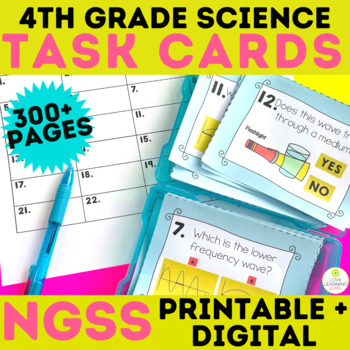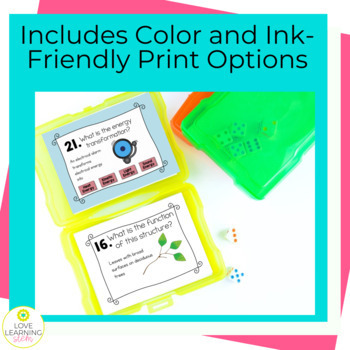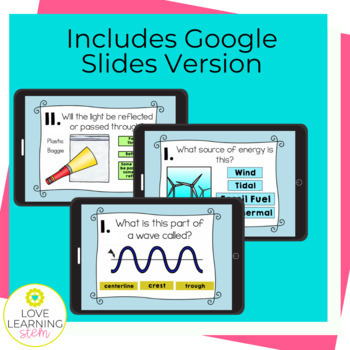4th Grade Science Task Cards for Review and Games - Printable and Google Slides
- Zip
- Google Apps™
- Internet Activities

What educators are saying
Products in this Bundle (9)
showing 1-5 of 9 products
Bonus
Also included in
- This 4th Grade Science Curriculum is everything you need to teach NGSS 4th grade science standards! It includes 6 complete unit: Energy, Light and Sound Waves, Renewable Energy, Rock Layers and Fossils, Weathering, Erosion, and Deposition, and Animal Structure and Function. With easy-to-download PDFPrice $199.00Original Price $427.75Save $228.75
Description
Are you looking for an engaging way to practice and review 4th grade science concepts? These 4th Grade Science Task Cards are a huge TIME SAVER, and students LOVE playing games or using these task cards.
The task cards in this bundle are both PRINTABLE and DIGITAL. The printable version allows for color printing as well ink-friendly black and white printing. The digital versions are created in Google Slides.
They are created to be used all year long and cover every NGSS 4th grade standard. It's a great activity for early finishers, science centers, morning work, and can be used for intervention strategies to review science standards.
Looking for the 5th grade Science Task Card Bundle?
Buy this Bundle and Save 30%
The Resources listed below cover all of the NGSS 4th grade standards:
- Potential and Kinetic Energy & Collisions 4-PS3-1-1 4-PS3-1-2 4-PS3-1-3
- Which has more energy? 4-PS3-1
- Renewable and Nonrenewable Energy 4-PS4
- Animal and Plant Structure and Function 4-LS1
- 5 Human Senses 4-LS1-2
- Weathering and Erosions 4-ESS2-1
- Waves and Information 4-PS4-1-4
- Engineering Design Process & Criteria and Constraints 3-5 ETS1-1-3
When can you use this resource?
- games for Fun Friday
- Google Meet/Zoom Poll Questions
- science centers
- science review in small groups
- re-teaching students who need extra assistance
- homework
- technology center work
- use with Special Education students
- check for understanding
- ticket out the door
- morning meeting
- substitute lesson or prep
What are teachers saying about these digital task cards?
"This resource allows my students to do the work at home. It is Google Classroom ready and was easy to assign to my students, thanks!"
"Loved that these were made for google slides! Thank you so much for taking the time to create a quality activity! This really helped my students!"
"This resource was great for my distance learners. Very easy to use and understand."
These Task Cards are also in Google Forms
These Task Cards are also in Boom Cards
Looking to buy individually?
- 5 Human Senses
- Animal and Plant Structure
- Engineering Design Process
- Properties of Light
- Weathering and Erosions
- Waves and Information
- Potential or Kinetic Energy?
- Transfer of Energy
- Renewable and Nonrenewable Energy
Games You Can Play With Task Cards
Whole Class Game – Scoot: Every child will be given the answer sheet. Have each child stand up behind their chair with their answer sheet and pencil. In front of each child, place one task card. Students are given a time limit of anywhere from 1-3 minutes, and in that time they will have to answer the question on the task card on their answer sheet. Once timer goes off, loudly say “SCOOT,” and students will have to go to the next desk and complete the task card at the desk. They will not collect the task cards and will only be traveling with their answer sheets and pencils. Practice the direction/rotation of students, so they know which is their next desk.
Science Center: Within your daily rotations add a science center. Students can complete these task cards. Cards will hold up better if they are laminated to withstand student use. The answer sheets can be kept in a file folder at the center or students can record their answers in a science notebook.
Quiz- Quiz- Trade: Give each child a task card and pair 2 students together. Students can record their answers on the answer sheet or simply practice verbally their responses. Partner 1 will ask Partner 2 the question on their card. Partner 2 will respond to the question or state that they don’t know the answer. Partner 1 will need to give the answer to the question if it is incorrect. Next partner will read their question. Once both questions have answered, students switch cards and move to the next pairing. It’s best if there is a timer, especially with younger students, and students are not allowed to run or speak loudly/yell.
Small Group Practice: Students that may need extra practice can be pulled in a small group together and go through the practice problems together.
Corners/Bell Ringer: Read the questions to the students in the beginning of class/lesson and have students to answer the question. You can do corners in the room. For example, if the question is ”What type of energy does this image represent?” You can have one corner of the room be “kinetic energy” and the other corner be “potential energy.” For best results, keep these short with 1-3 questions.
Looking for more 4th Grade NGSS Science Units?
- Complete Curriculum for the Year
- Energy Unit (Paper and Digital)
- Energy Unit (Paper ONLY)
- Animal and Plant Structure and Function Unit
- Earth Science Unit
- Human Impact on the Earth Unit
- Waves and Information Unit
Questions?
If you have any questions, please do not hesitate to email me at liana@lovelearningstem.com.
Follow me on Teachers Pay Teachers because all knew resources are uploaded at 50% off for the first 24 hours! It literally pays to follow me! Click here to follow me on TPT
Don't forget to rate the resource in "My Purchases" from your Dashboard so you can get free credits for future purchases. I love hearing how you've used my resources in your classrooms and with your children.
Find Me Here!






